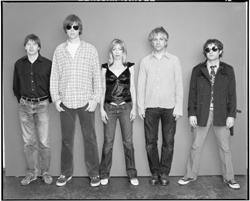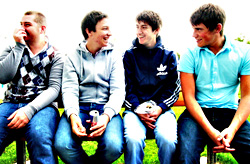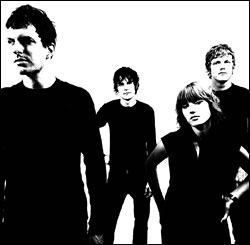Fuck Daydream Nation. Sure, as monuments go, the album is holding up far better than Ronald Reagan’s new cement peep-show tank ever will, but the 1988 magnum opus looms a bit too large over Sonic Youth’s 23-year career. They’ve done everything they could to wriggle out of its shadow—from Goo‘s straight-ahead power rock to the measured explorations of Goodbye 20th Century—without ever breaking free. It’s almost enough to make a person grateful for the handful of crackpots who insist to this very day that “Death Valley ’69” was the best thing SY ever did and dismiss everything after Evol as uninspired sellout.
Even those fools might be inclined to embrace Sonic Nurse (DGC), along with the old-school Johnny- and Janey-come-latelies who slithered quietly off the bandwagon shortly after the band stopped doing Ramones covers live and the youngsters who decried 2002’s Murray Street as proof that the band had finally attained old-and-in-the-way status. Nurse is nowhere near as overtly labor intensive as its antecedents; therein lies much of its charm. Daydream Nation was Sonic Youth’s first great baby Beat adventure, a cross-country road trip of Wagnerian proportions. On the equally panoramic Nurse, they reveal that their other car is a broom.
This they do slowly. At first, album-opening rocker and undeclared diptych “Pattern Recognition” reads like more of the same new thing. Sneaky guitars wriggle around bassist-turned-guitarist/singer Kim Gordon’s anxious vocal like electric snakes as she coos and yelps through a skeletal synopsis of William Gibson’s latest novel. (To the best of my knowledge, no movie studio has optioned Pattern Recognition yet. Let’s examine this: William Gibson novel; takes place in present; international intrigue; CIA–9/11 subplot; spooky hacker shit; cute female protagonist; subculture shit. Hmmm—what’s the likelihood of a film adaptation? And who’s gonna be sitting on top of the soundtrack heap?) The song’s apparent ending, an economically sprawling doom riff that begs to be looped, signals the beginning of part two, as undulating filaments of feedback coursing through a viscous drone swell to firestorm ferocity, then evaporate like giant amoebas hitting a maximum-voltage fence, caterwauling ghosts in a caustic tsunami.
None of “Pattern Recognition”‘s elements are unfamiliar; to paraphrase grossly underrecognized Beat writer and Thurston Moore colleague Charles Plymell, rock is rock and noise is noise, and Sonic Youth have known both. But part one’s instrumental interlude, a meticulously constructed latticework of cantilevered guitars, serves as a cogent reminder that the band have never stopped perfecting the post–no wave mudras they invented in the early ’80s, just as the song’s second half illustrates that they’re every bit as adept at moving ample slabs of undomesticated sound around as Merzbow or Borbetomagus. The sureness of the song’s juxtapositions is such that they seem to be declaring, “The first round of experiments has been completed; here are the results.”
But that all comes later. As with the three songs that follow, “Pattern Recognition”‘s spectacular aspects lurk as background issues on the first few listens. The ensemble seems so self- assured, so comfortable in its own conceptual epidermis, that it doesn’t make a whole lot of ado about anything—even on the fuzz-saturated “Kim Gordon and the Arthur Doyle Hand Cream,” a track that finds Gordon mugging with her vocal cords like a 7-year-old Lily Tomlin auditioning for the lead in The Diamanda Galas Story.
Only on “Stones” do they fully reveal their newfound prowess. Ostensibly a marriage of Murray Street‘s classic rock—including a deliciously sticky-fingered chorus—with the classier facets of SY’s expanded tonal palette, the song breaks down into drumlessness as Gordon and guitarists Moore and Lee Ranaldo launch a two-chord pattern that tumesces slowly before drummer Steve Shelley snaps them back into the song proper. The gambit goes back to the band’s first EP, but this time it seems completely right: The accumulated harmonics offer more in the way of color and unfold more rigorously. Plus, thanks to bassist Jim O’Rourke’s perfectly situated bell tones, the passage retains a sense of suspense despite the fact that its resolution is obvious from the get-go. Sonic Youth no longer seem to be dealing with sound as vibrating air molecules, instead manipulating it like light slowed to the point of audibility.
“Stones” might be the most finely detailed song SY have ever recorded; at the very least, it demonstrates the extent to which they now own the Grateful Dead’s measure-to-measure pursuit of infinite variety. But, unlike the Dead, Sonic Youth can take the lilt or leave it. On Ranaldo’s “Paper Cup Exit,” they opt for the latter. The sinister, midtempo rumbler waxes every bit as monolithic as “Kool Thing,” right down to its Shelley-driven freak-out, providing a perfect setup for the delicate “I Love You Golden Blue.” Sounding more fragile than ever before, Gordon (who manages to cover a ridiculous amount of ground in the course of four songs) sighs, “Dead boy stares/Strange to meet you/Dead boy cares/So great to see you.” Is the song about someone she knows? Probably—but that’s not the point. It brings the album back to human scale just in time for Moore’s gently rolling protest song, “Peace Attack,” and yet another majestic guitar interlude (breezy this time). The album closes with Thurston chortling, “Springtime is wartime/I’ll rise to the crime boss/Electric guitar string/Prairie flowers.”
Ending a record as expansive as Nurse on such a modest note is a trick that’s all the dirtier for working as well as it does; it creates a sense of disbelief that can only be allayed by listening to the record again in its entirety. It also demonstrates the extent to which Sonic Youth have mastered the art of being themselves. They don’t even have to work at it anymore, and they don’t; they just let their intrinsic Sonic Youthness flow, like traffic. Sonic Nurse might be just a little better than Daydream Nation; it’ll take at least another 16 years to figure that out. At the very least, it’s sure as hell not any worse.
Sonic Youth play the Showbox with Wolf Eyes at 8 p.m. Wed., July 14. $25 adv. All ages.








